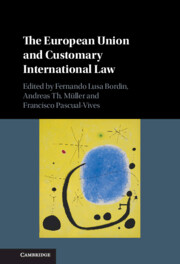Book contents
- The European Union and Customary International Law
- The European Union and Customary International Law
- Copyright page
- Contents
- Contributors
- Acknowledgements
- Cases
- Treaties
- Abbreviations
- Introduction
- Part I A View from the Outside
- Part II Looking in Between
- 4 Customary Law within the Internal Legal Sphere of the European Union
- 5 The Identification of Customary International Law Before the Court of Justice of the European Union
- 6 Patterns of Avoidance and Assimilation
- Part III A View from the Inside
- Index
5 - The Identification of Customary International Law Before the Court of Justice of the European Union
A Flexible Consensualism
from Part II - Looking in Between
Published online by Cambridge University Press: 27 October 2022
- The European Union and Customary International Law
- The European Union and Customary International Law
- Copyright page
- Contents
- Contributors
- Acknowledgements
- Cases
- Treaties
- Abbreviations
- Introduction
- Part I A View from the Outside
- Part II Looking in Between
- 4 Customary Law within the Internal Legal Sphere of the European Union
- 5 The Identification of Customary International Law Before the Court of Justice of the European Union
- 6 Patterns of Avoidance and Assimilation
- Part III A View from the Inside
- Index
Summary
This chapter studies the methodology used by the CJEU to identify CIL. In addition, it assesses whether that methodology is similar to, or differs from, that which other international courts and tribunals use (based on the two-element approach). The chapter argues that the notion of consensus can assist the CJEU in the identification process of CIL. In particular, two sets of cases are examined. First, those in which the CJEU has dealt with the interaction between the Resolutions of the UNGA and CIL in the identification process. And secondly, cases where general principles of public international law have been used to identify CIL. Resorting to public international law concepts (consensus) and techniques (external references to the PCIJ or the ILC) to identify CIL does not prevent the CJEU from adopting a particularist approach. The judicial practice analysed highlights the tension converging when the CJEU exercises its jurisdiction. A push towards autonomy (or particularism) can be noted on the one hand. On the other hand, the CJEU cannot avoid its nature as an international tribunal. The chapter argues that it is precisely for this reason that the CJEU resorts to a ‘flexible consensualist approach’ when faced with the identification of CIL thus allowing some room for cross-fertilization between international courts and tribunals.
Keywords
- Type
- Chapter
- Information
- The European Union and Customary International Law , pp. 123 - 147Publisher: Cambridge University PressPrint publication year: 2022



